Analysis of Cloud Computing Architectures for Regional Gardens
VerifiedAdded on 2021/04/22
|11
|919
|76
Report
AI Summary
This report focuses on cloud computing architectures suitable for Regional Gardens, evaluating Infrastructure as a Service (IaaS), Platform as a Service (PaaS), and Software as a Service (SaaS). The analysis begins with an overview of cloud computing, its advantages, and different types of cloud architectures. The report then delves into the specifics of IaaS, PaaS, and SaaS, discussing their functionalities, benefits, and applications. It considers the current infrastructure of Regional Gardens, which includes Windows Server 2008 R2 and 2003, SQL Server, and Exchange 2007. Based on this analysis, the report recommends IaaS as the most suitable cloud infrastructure for Regional Gardens, highlighting its flexibility, scalability, and cost-effectiveness. The report also includes a list of relevant references to support the findings.
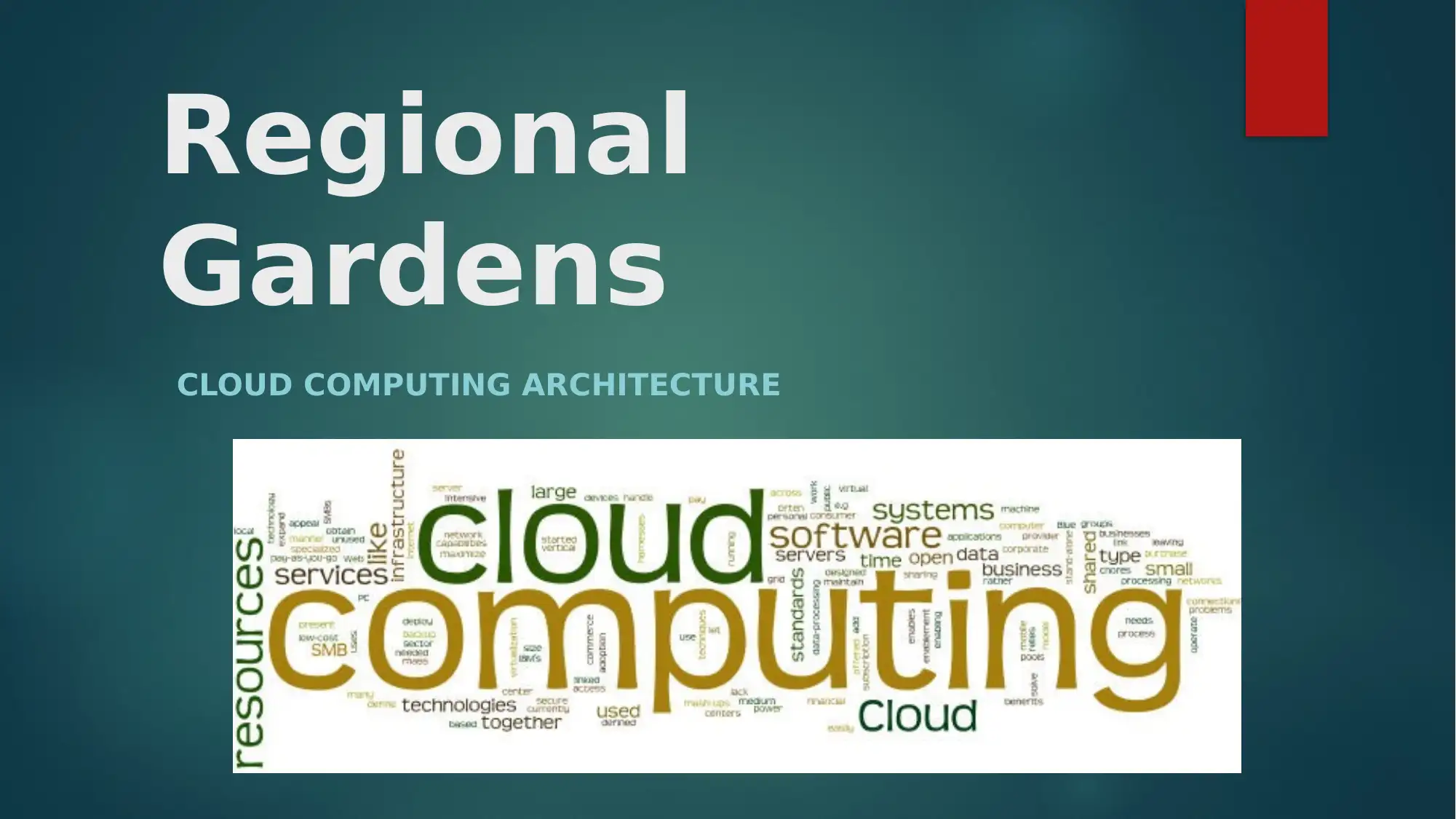
Regional
Gardens
CLOUD COMPUTING ARCHITECTURE
Gardens
CLOUD COMPUTING ARCHITECTURE
Paraphrase This Document
Need a fresh take? Get an instant paraphrase of this document with our AI Paraphraser
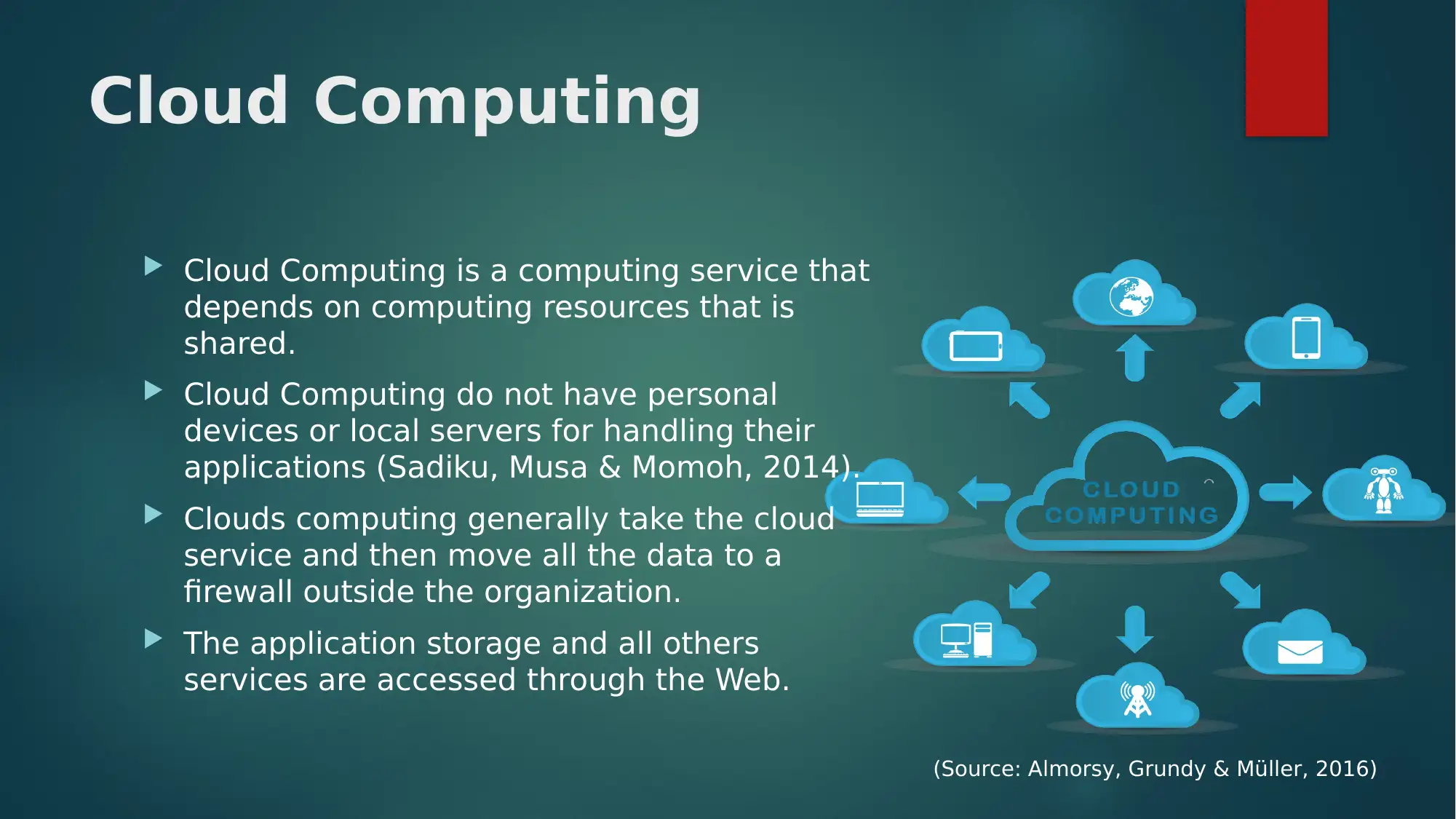
Cloud Computing
Cloud Computing is a computing service that
depends on computing resources that is
shared.
Cloud Computing do not have personal
devices or local servers for handling their
applications (Sadiku, Musa & Momoh, 2014).
Clouds computing generally take the cloud
service and then move all the data to a
firewall outside the organization.
The application storage and all others
services are accessed through the Web.
(Source: Almorsy, Grundy & Müller, 2016)
Cloud Computing is a computing service that
depends on computing resources that is
shared.
Cloud Computing do not have personal
devices or local servers for handling their
applications (Sadiku, Musa & Momoh, 2014).
Clouds computing generally take the cloud
service and then move all the data to a
firewall outside the organization.
The application storage and all others
services are accessed through the Web.
(Source: Almorsy, Grundy & Müller, 2016)
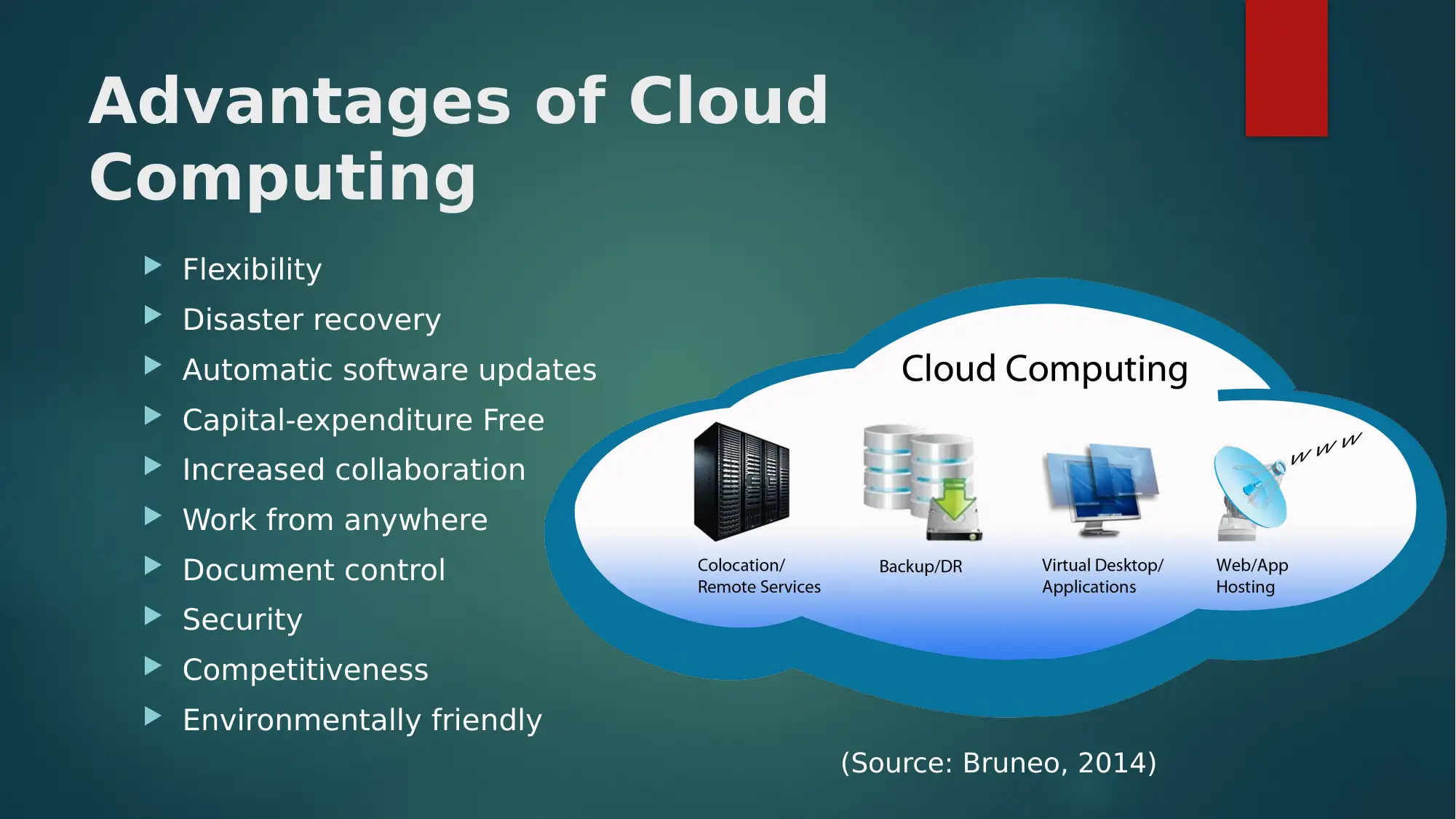
Advantages of Cloud
Computing
Flexibility
Disaster recovery
Automatic software updates
Capital-expenditure Free
Increased collaboration
Work from anywhere
Document control
Security
Competitiveness
Environmentally friendly
(Source: Bruneo, 2014)
Computing
Flexibility
Disaster recovery
Automatic software updates
Capital-expenditure Free
Increased collaboration
Work from anywhere
Document control
Security
Competitiveness
Environmentally friendly
(Source: Bruneo, 2014)
⊘ This is a preview!⊘
Do you want full access?
Subscribe today to unlock all pages.

Trusted by 1+ million students worldwide
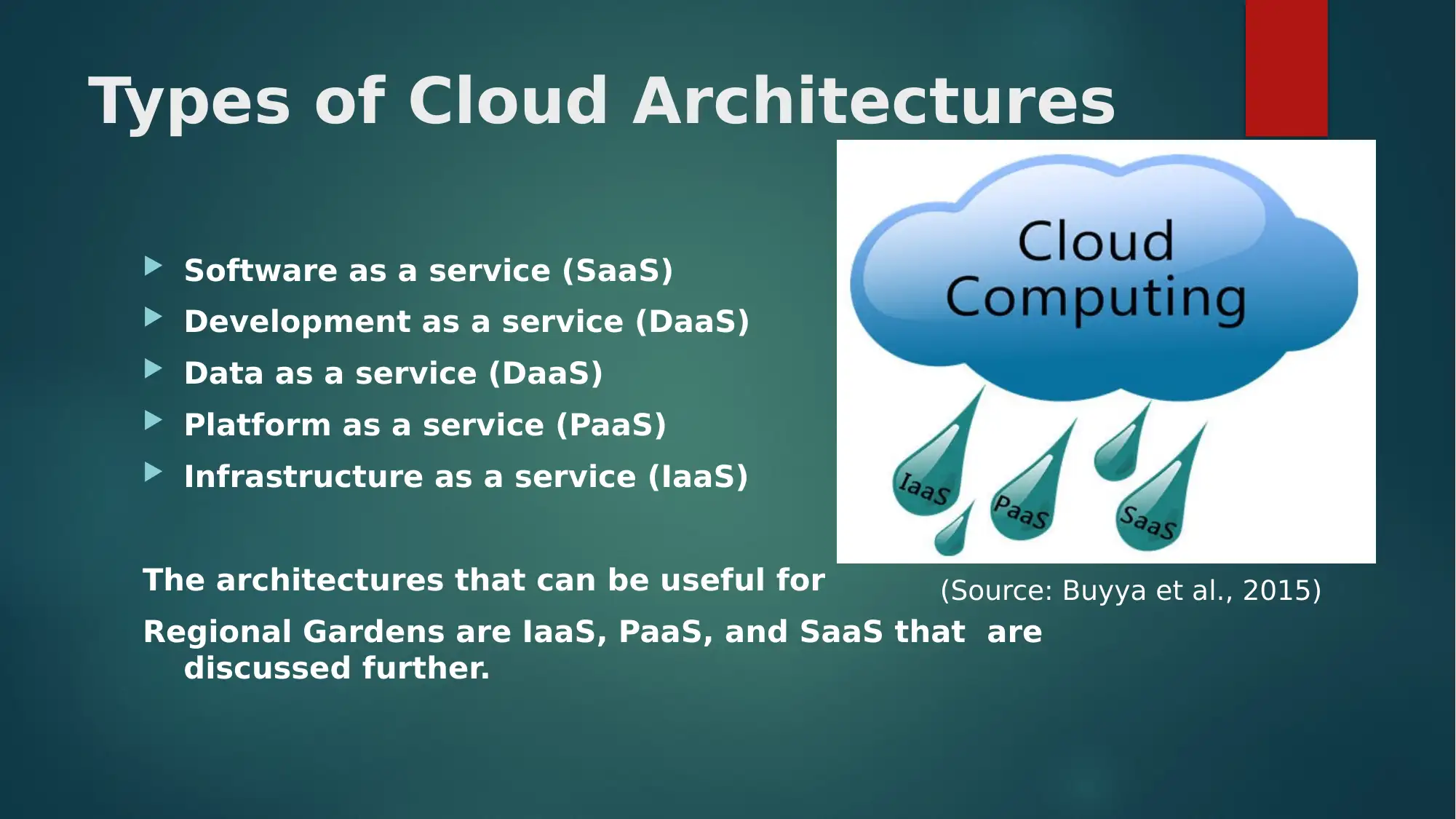
Types of Cloud Architectures
Software as a service (SaaS)
Development as a service (DaaS)
Data as a service (DaaS)
Platform as a service (PaaS)
Infrastructure as a service (IaaS)
The architectures that can be useful for
Regional Gardens are IaaS, PaaS, and SaaS that are
discussed further.
(Source: Buyya et al., 2015)
Software as a service (SaaS)
Development as a service (DaaS)
Data as a service (DaaS)
Platform as a service (PaaS)
Infrastructure as a service (IaaS)
The architectures that can be useful for
Regional Gardens are IaaS, PaaS, and SaaS that are
discussed further.
(Source: Buyya et al., 2015)
Paraphrase This Document
Need a fresh take? Get an instant paraphrase of this document with our AI Paraphraser
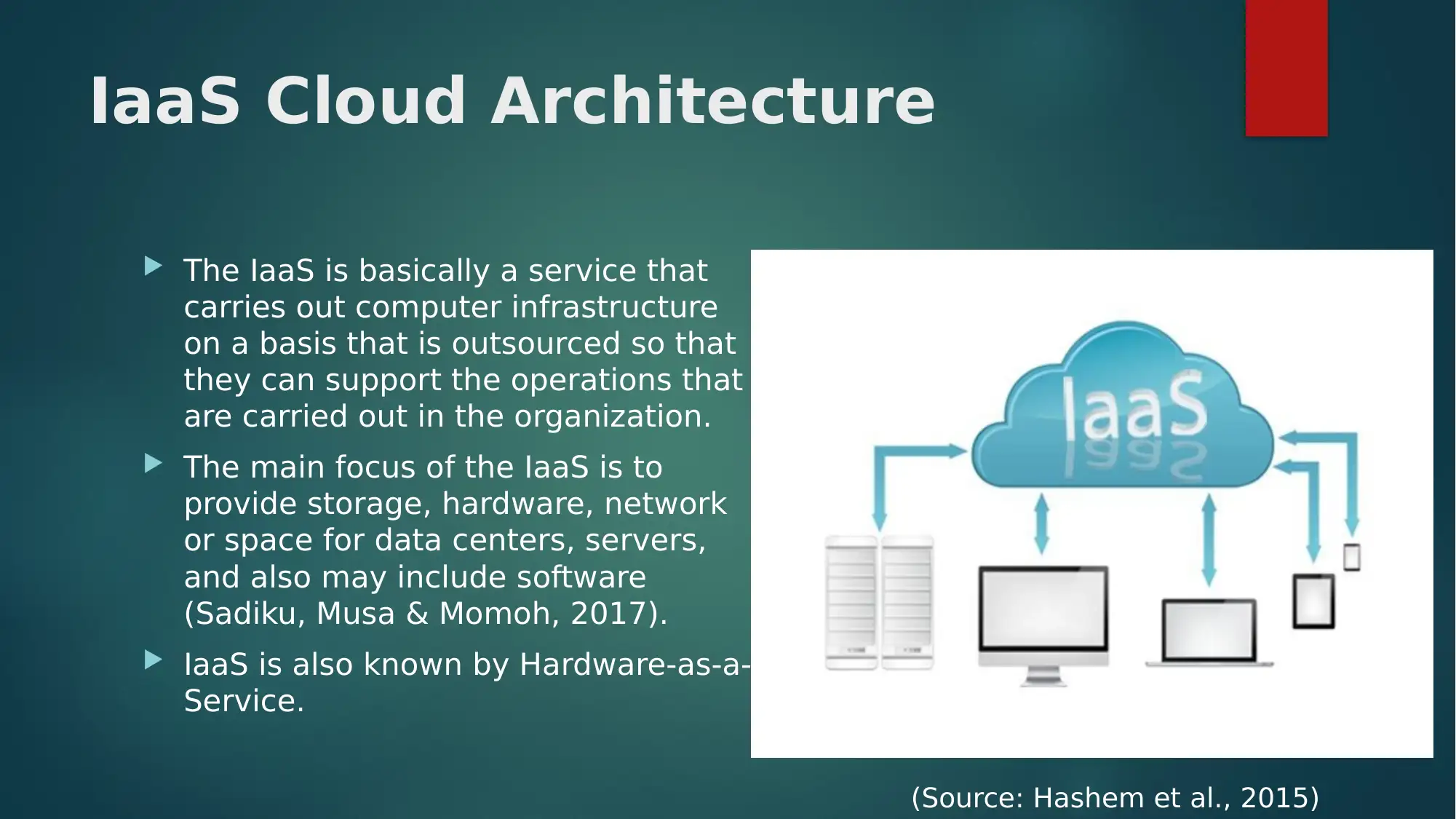
IaaS Cloud Architecture
The IaaS is basically a service that
carries out computer infrastructure
on a basis that is outsourced so that
they can support the operations that
are carried out in the organization.
The main focus of the IaaS is to
provide storage, hardware, network
or space for data centers, servers,
and also may include software
(Sadiku, Musa & Momoh, 2017).
IaaS is also known by Hardware-as-a-
Service.
(Source: Hashem et al., 2015)
The IaaS is basically a service that
carries out computer infrastructure
on a basis that is outsourced so that
they can support the operations that
are carried out in the organization.
The main focus of the IaaS is to
provide storage, hardware, network
or space for data centers, servers,
and also may include software
(Sadiku, Musa & Momoh, 2017).
IaaS is also known by Hardware-as-a-
Service.
(Source: Hashem et al., 2015)
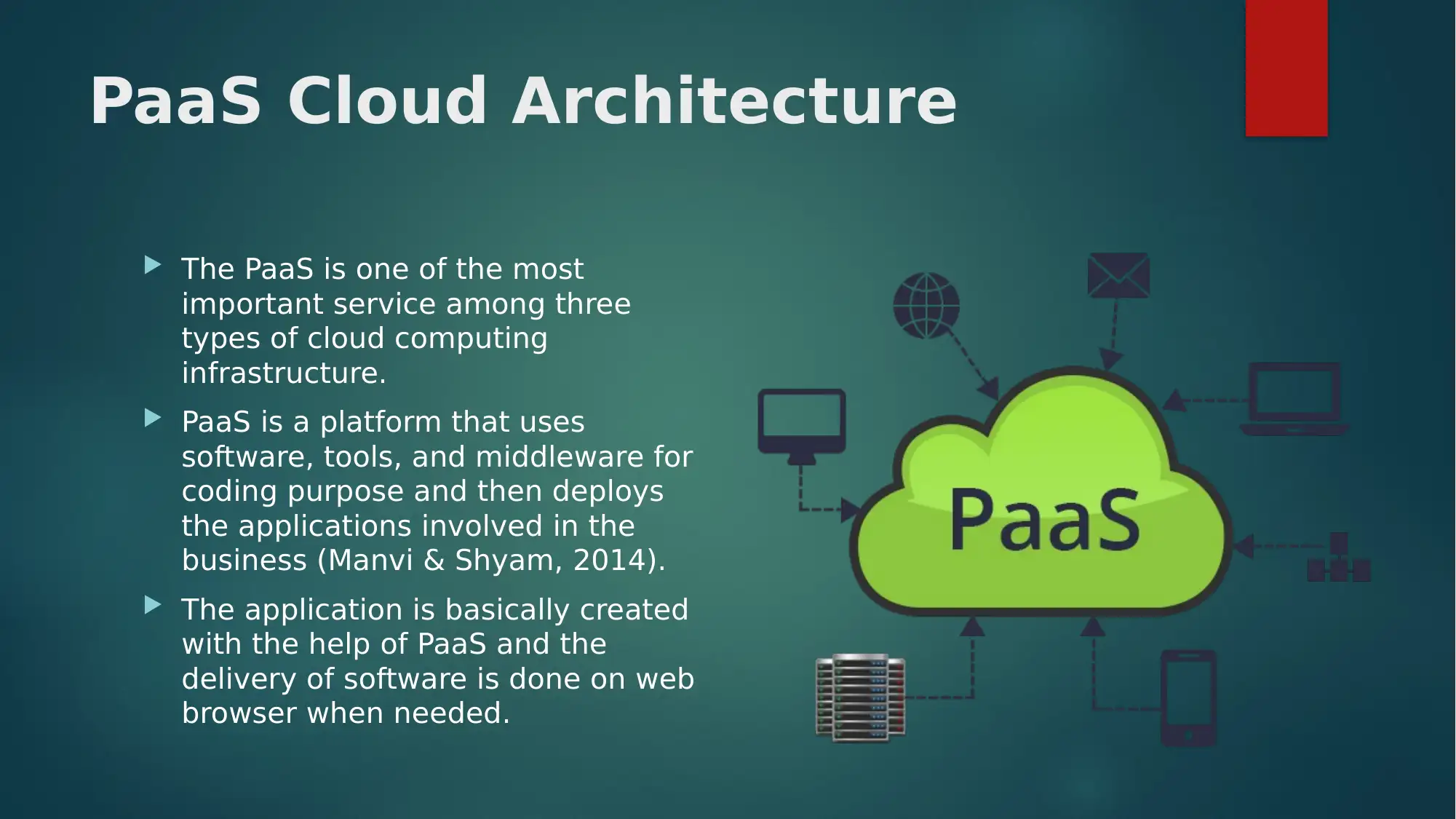
PaaS Cloud Architecture
The PaaS is one of the most
important service among three
types of cloud computing
infrastructure.
PaaS is a platform that uses
software, tools, and middleware for
coding purpose and then deploys
the applications involved in the
business (Manvi & Shyam, 2014).
The application is basically created
with the help of PaaS and the
delivery of software is done on web
browser when needed.
The PaaS is one of the most
important service among three
types of cloud computing
infrastructure.
PaaS is a platform that uses
software, tools, and middleware for
coding purpose and then deploys
the applications involved in the
business (Manvi & Shyam, 2014).
The application is basically created
with the help of PaaS and the
delivery of software is done on web
browser when needed.
⊘ This is a preview!⊘
Do you want full access?
Subscribe today to unlock all pages.

Trusted by 1+ million students worldwide
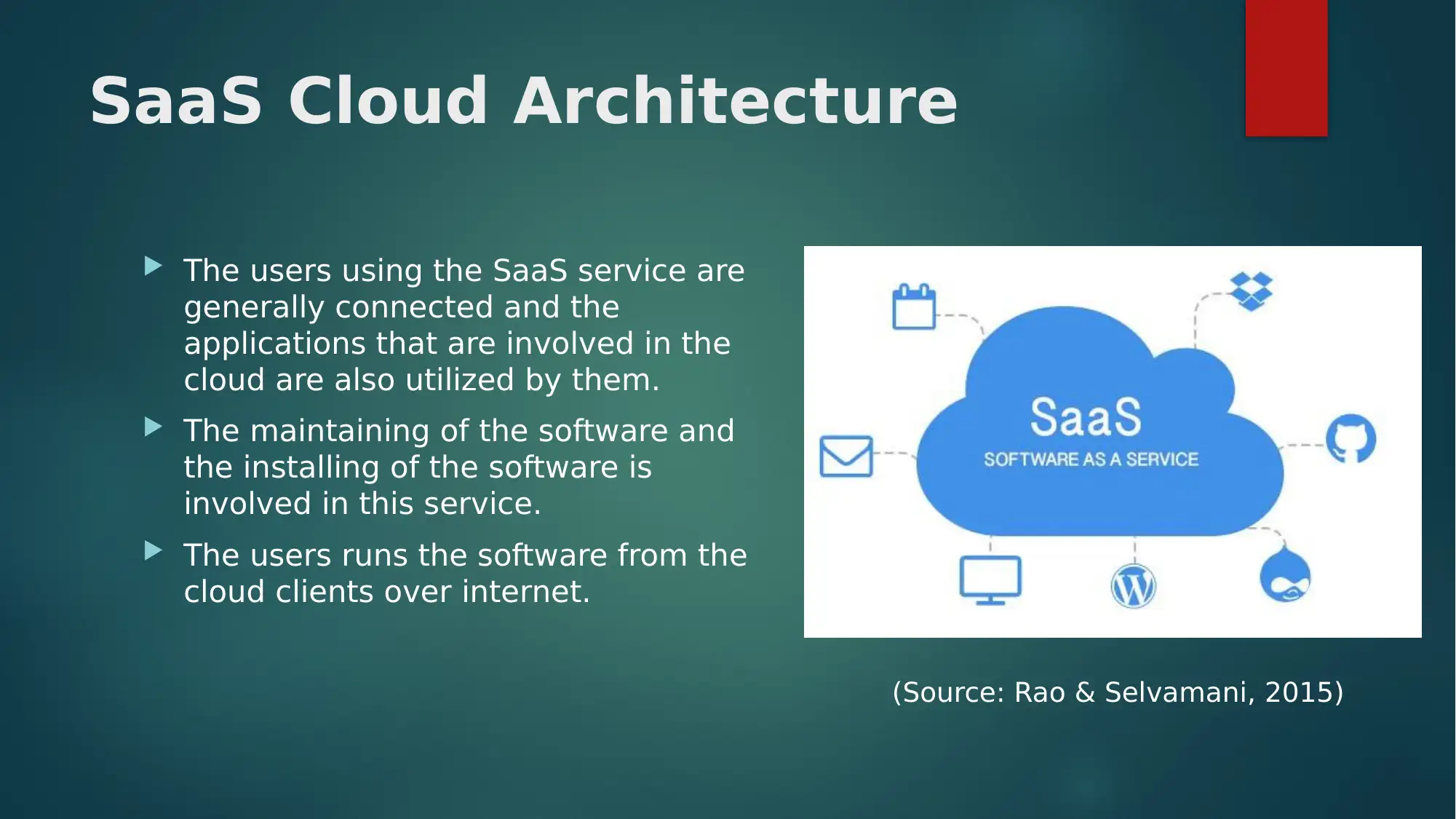
SaaS Cloud Architecture
The users using the SaaS service are
generally connected and the
applications that are involved in the
cloud are also utilized by them.
The maintaining of the software and
the installing of the software is
involved in this service.
The users runs the software from the
cloud clients over internet.
(Source: Rao & Selvamani, 2015)
The users using the SaaS service are
generally connected and the
applications that are involved in the
cloud are also utilized by them.
The maintaining of the software and
the installing of the software is
involved in this service.
The users runs the software from the
cloud clients over internet.
(Source: Rao & Selvamani, 2015)
Paraphrase This Document
Need a fresh take? Get an instant paraphrase of this document with our AI Paraphraser
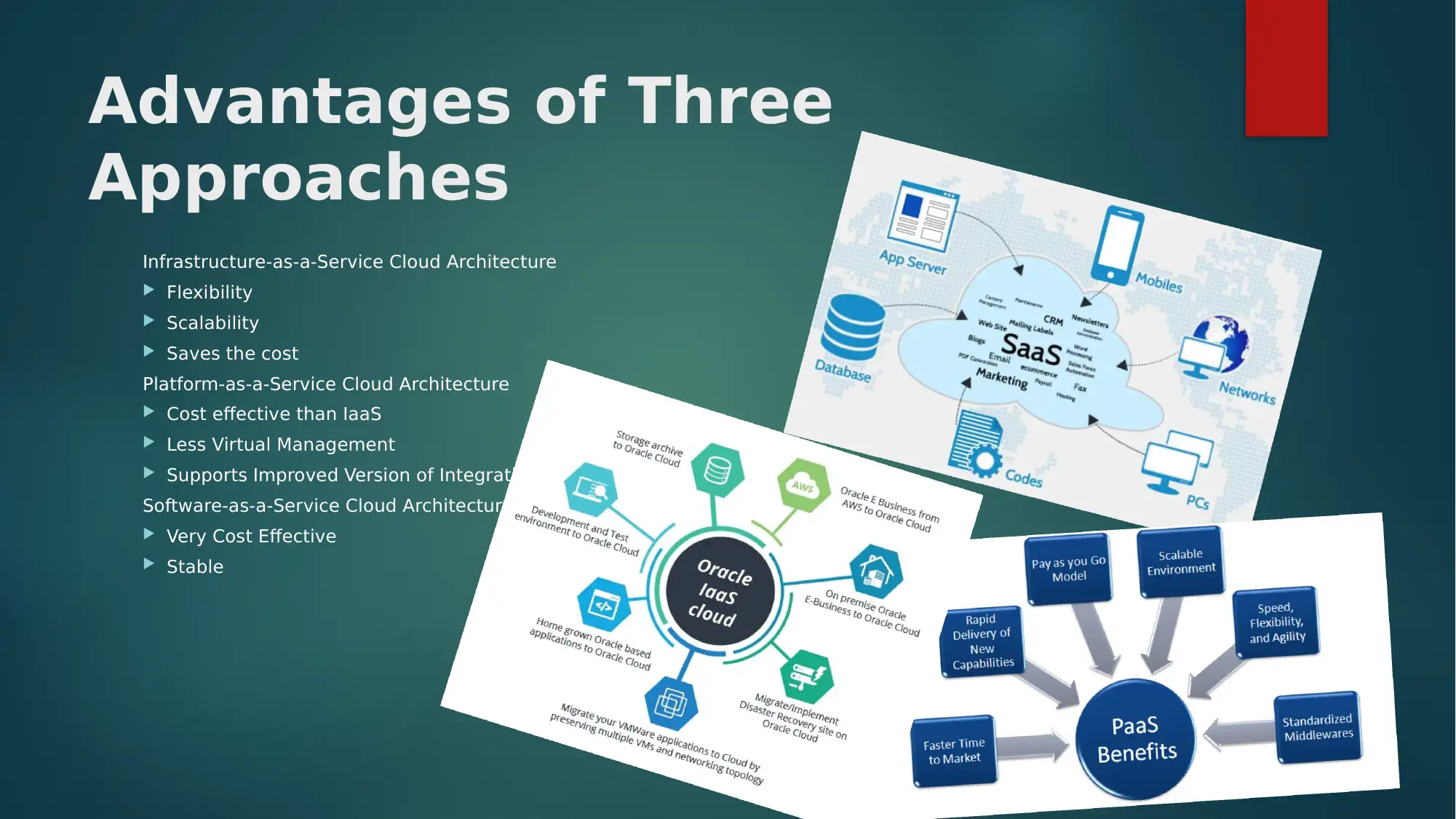
Advantages of Three
Approaches
Infrastructure-as-a-Service Cloud Architecture
Flexibility
Scalability
Saves the cost
Platform-as-a-Service Cloud Architecture
Cost effective than IaaS
Less Virtual Management
Supports Improved Version of Integration
Software-as-a-Service Cloud Architecture
Very Cost Effective
Stable
Approaches
Infrastructure-as-a-Service Cloud Architecture
Flexibility
Scalability
Saves the cost
Platform-as-a-Service Cloud Architecture
Cost effective than IaaS
Less Virtual Management
Supports Improved Version of Integration
Software-as-a-Service Cloud Architecture
Very Cost Effective
Stable
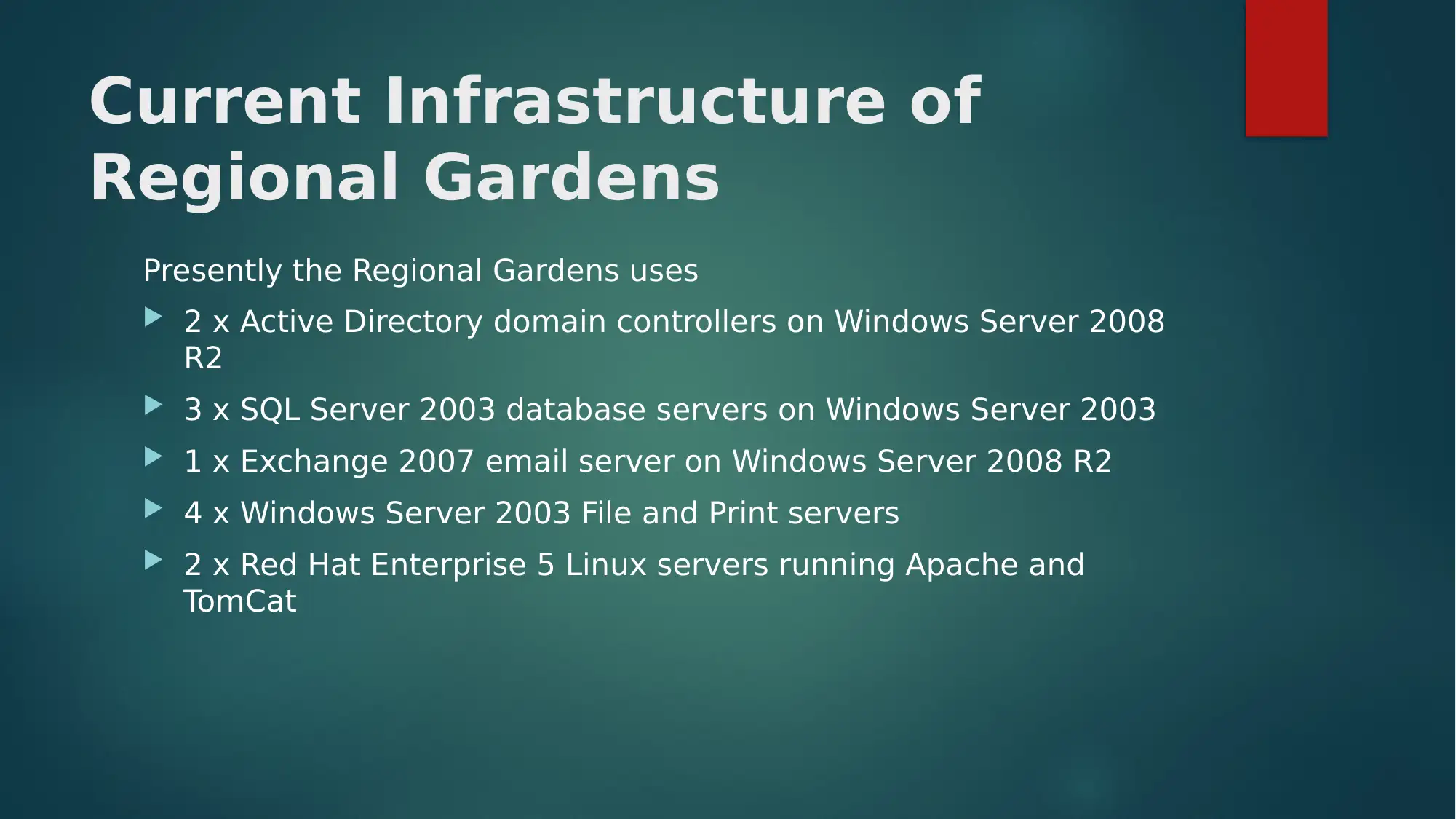
Current Infrastructure of
Regional Gardens
Presently the Regional Gardens uses
2 x Active Directory domain controllers on Windows Server 2008
R2
3 x SQL Server 2003 database servers on Windows Server 2003
1 x Exchange 2007 email server on Windows Server 2008 R2
4 x Windows Server 2003 File and Print servers
2 x Red Hat Enterprise 5 Linux servers running Apache and
TomCat
Regional Gardens
Presently the Regional Gardens uses
2 x Active Directory domain controllers on Windows Server 2008
R2
3 x SQL Server 2003 database servers on Windows Server 2003
1 x Exchange 2007 email server on Windows Server 2008 R2
4 x Windows Server 2003 File and Print servers
2 x Red Hat Enterprise 5 Linux servers running Apache and
TomCat
⊘ This is a preview!⊘
Do you want full access?
Subscribe today to unlock all pages.

Trusted by 1+ million students worldwide
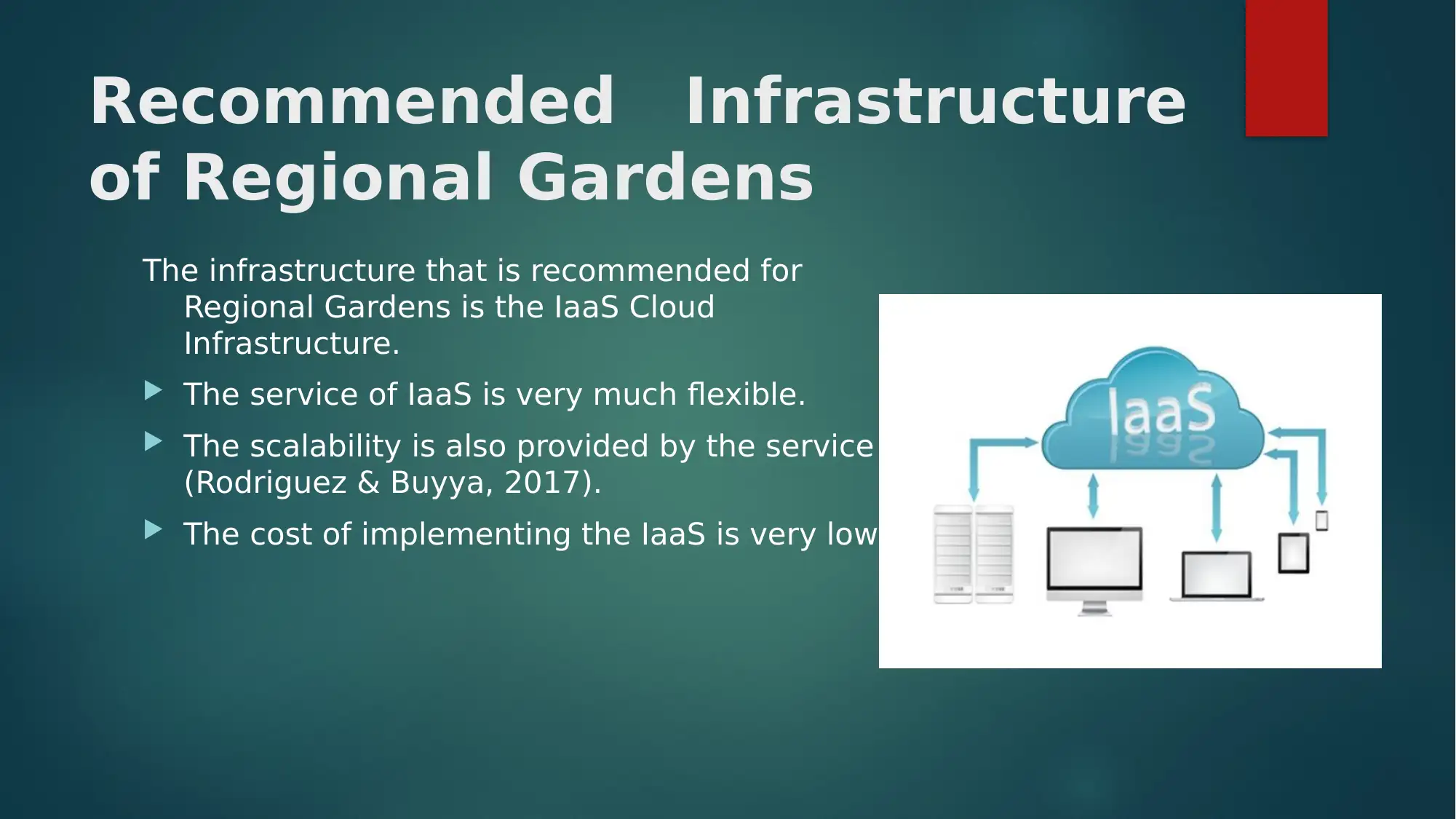
Recommended Infrastructure
of Regional Gardens
The infrastructure that is recommended for
Regional Gardens is the IaaS Cloud
Infrastructure.
The service of IaaS is very much flexible.
The scalability is also provided by the service
(Rodriguez & Buyya, 2017).
The cost of implementing the IaaS is very low .
of Regional Gardens
The infrastructure that is recommended for
Regional Gardens is the IaaS Cloud
Infrastructure.
The service of IaaS is very much flexible.
The scalability is also provided by the service
(Rodriguez & Buyya, 2017).
The cost of implementing the IaaS is very low .
Paraphrase This Document
Need a fresh take? Get an instant paraphrase of this document with our AI Paraphraser
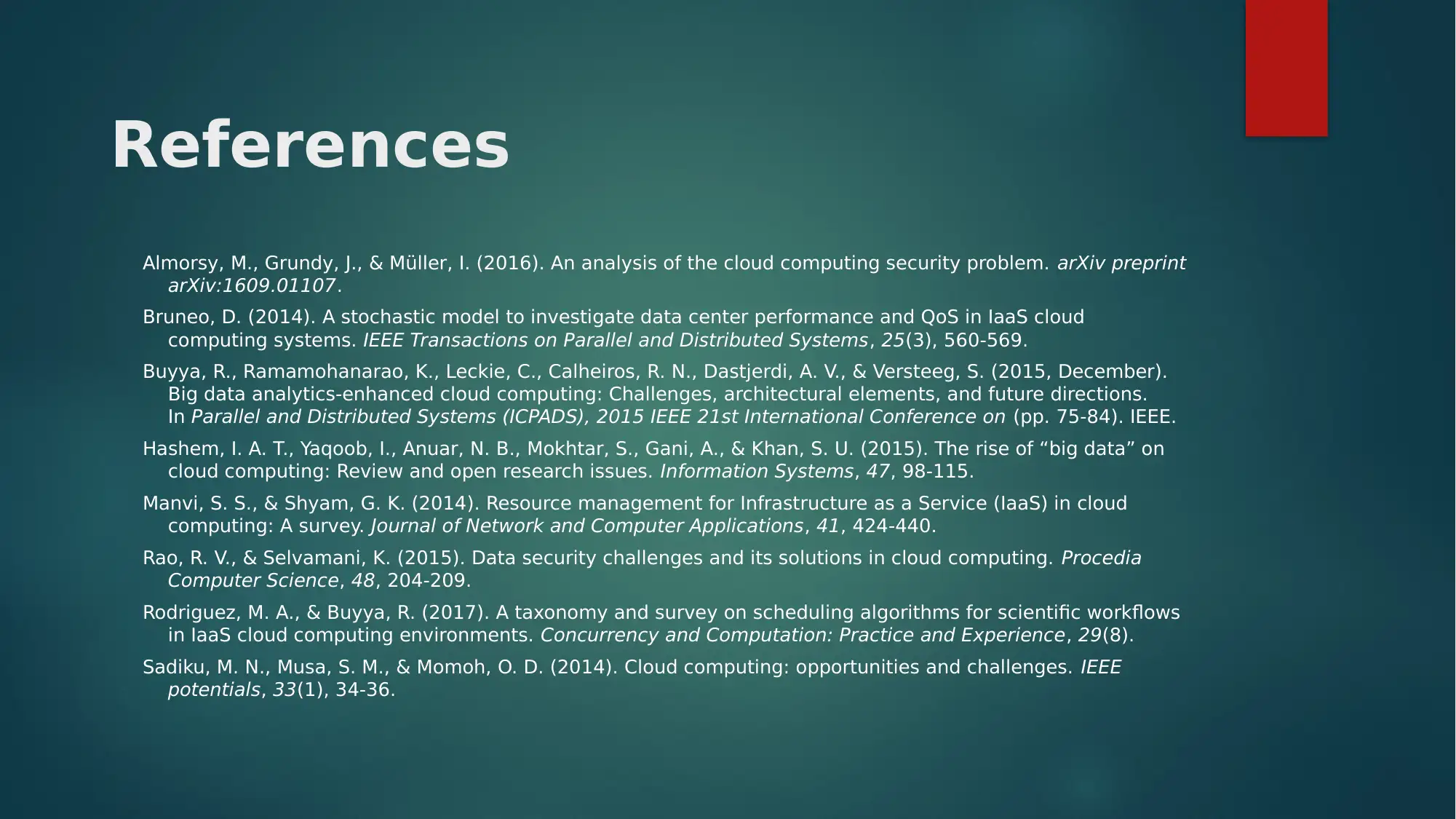
References
Almorsy, M., Grundy, J., & Müller, I. (2016). An analysis of the cloud computing security problem. arXiv preprint
arXiv:1609.01107.
Bruneo, D. (2014). A stochastic model to investigate data center performance and QoS in IaaS cloud
computing systems. IEEE Transactions on Parallel and Distributed Systems, 25(3), 560-569.
Buyya, R., Ramamohanarao, K., Leckie, C., Calheiros, R. N., Dastjerdi, A. V., & Versteeg, S. (2015, December).
Big data analytics-enhanced cloud computing: Challenges, architectural elements, and future directions.
In Parallel and Distributed Systems (ICPADS), 2015 IEEE 21st International Conference on (pp. 75-84). IEEE.
Hashem, I. A. T., Yaqoob, I., Anuar, N. B., Mokhtar, S., Gani, A., & Khan, S. U. (2015). The rise of “big data” on
cloud computing: Review and open research issues. Information Systems, 47, 98-115.
Manvi, S. S., & Shyam, G. K. (2014). Resource management for Infrastructure as a Service (IaaS) in cloud
computing: A survey. Journal of Network and Computer Applications, 41, 424-440.
Rao, R. V., & Selvamani, K. (2015). Data security challenges and its solutions in cloud computing. Procedia
Computer Science, 48, 204-209.
Rodriguez, M. A., & Buyya, R. (2017). A taxonomy and survey on scheduling algorithms for scientific workflows
in IaaS cloud computing environments. Concurrency and Computation: Practice and Experience, 29(8).
Sadiku, M. N., Musa, S. M., & Momoh, O. D. (2014). Cloud computing: opportunities and challenges. IEEE
potentials, 33(1), 34-36.
Almorsy, M., Grundy, J., & Müller, I. (2016). An analysis of the cloud computing security problem. arXiv preprint
arXiv:1609.01107.
Bruneo, D. (2014). A stochastic model to investigate data center performance and QoS in IaaS cloud
computing systems. IEEE Transactions on Parallel and Distributed Systems, 25(3), 560-569.
Buyya, R., Ramamohanarao, K., Leckie, C., Calheiros, R. N., Dastjerdi, A. V., & Versteeg, S. (2015, December).
Big data analytics-enhanced cloud computing: Challenges, architectural elements, and future directions.
In Parallel and Distributed Systems (ICPADS), 2015 IEEE 21st International Conference on (pp. 75-84). IEEE.
Hashem, I. A. T., Yaqoob, I., Anuar, N. B., Mokhtar, S., Gani, A., & Khan, S. U. (2015). The rise of “big data” on
cloud computing: Review and open research issues. Information Systems, 47, 98-115.
Manvi, S. S., & Shyam, G. K. (2014). Resource management for Infrastructure as a Service (IaaS) in cloud
computing: A survey. Journal of Network and Computer Applications, 41, 424-440.
Rao, R. V., & Selvamani, K. (2015). Data security challenges and its solutions in cloud computing. Procedia
Computer Science, 48, 204-209.
Rodriguez, M. A., & Buyya, R. (2017). A taxonomy and survey on scheduling algorithms for scientific workflows
in IaaS cloud computing environments. Concurrency and Computation: Practice and Experience, 29(8).
Sadiku, M. N., Musa, S. M., & Momoh, O. D. (2014). Cloud computing: opportunities and challenges. IEEE
potentials, 33(1), 34-36.
1 out of 11
Related Documents
Your All-in-One AI-Powered Toolkit for Academic Success.
+13062052269
info@desklib.com
Available 24*7 on WhatsApp / Email
![[object Object]](/_next/static/media/star-bottom.7253800d.svg)
Unlock your academic potential
Copyright © 2020–2025 A2Z Services. All Rights Reserved. Developed and managed by ZUCOL.





